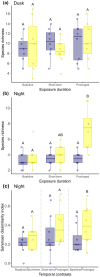Artificial Light Increases Nighttime Prevalence of Predatory Fishes, Altering Community Composition on Coral Reefs
- PMID: 39692005
- PMCID: PMC11653166
- DOI: 10.1111/gcb.70002
Artificial Light Increases Nighttime Prevalence of Predatory Fishes, Altering Community Composition on Coral Reefs
Abstract
Artificial light at night (ALAN) is an anthropogenic pollutant that is intensifying and expanding in marine environments, but experimental studies of community-level effects are generally lacking. The inshore, shallow, and clear-water locations of coral reefs and their diverse photosensitive inhabitants make these ecosystems highly susceptible to biological disturbances; at the same time, their biodiversity and accessibility make them model systems for wider insight. Here, we experimentally manipulated ALAN using underwater LED lights on a Polynesian reef system to investigate the influence on localised nighttime fish communities compared to control sites without ALAN. We collected infrared video censuses of baseline communities prior to manipulation, which we repeated following short-term (mean of three nights) and prolonged (mean of 25 nights) exposures to ALAN. Short-term ALAN exposure did not induce any significant alterations to the nighttime fish community, but prolonged ALAN exposure increased nighttime species richness. Species compositions exposed to prolonged ALAN were more dissimilar from their baseline compared to control sites. The difference between community compositions at prolonged ALAN exposure and control sites was not apparent at the family level; instead, it was observed from the composition of trait guilds. Following prolonged ALAN exposure, more diurnal and nocturnal predatory species (piscivores, invertivores, and planktivores)-particularly those that are site-attached or mobile within reefs-were present in nighttime assemblages. Our experimental findings show that coastal ALAN could cause trophic imbalances and circadian disturbances in localised nighttime reef fish communities. Given that community-wide consequences were only apparent after prolonged ALAN exposure suggests that management of the duration of artificial lighting could potentially be used to reduce impacts on marine ecosystems.
Keywords: ALAN; coral reef fish; exposure duration; field experiment; nighttime fish community; nocturnal fish; predators.
Global Change Biology© 2024 The Author(s). Global Change Biology published by John Wiley & Sons Ltd.
Conflict of interest statement
The authors declare no conflicts of interest.
Figures




Similar articles
-
The impacts of artificial light at night on the ecology of temperate and tropical reefs.Philos Trans R Soc Lond B Biol Sci. 2023 Dec 18;378(1892):20220362. doi: 10.1098/rstb.2022.0362. Epub 2023 Oct 30. Philos Trans R Soc Lond B Biol Sci. 2023. PMID: 37899007 Free PMC article. Review.
-
Physical, biological and anthropogenic drivers of spatial patterns of coral reef fish assemblages at regional and local scales.Sci Total Environ. 2023 Dec 15;904:166695. doi: 10.1016/j.scitotenv.2023.166695. Epub 2023 Sep 1. Sci Total Environ. 2023. PMID: 37660823
-
Effects of depth on reef fish communities: Insights of a "deep refuge hypothesis" from Southwestern Atlantic reefs.PLoS One. 2018 Sep 26;13(9):e0203072. doi: 10.1371/journal.pone.0203072. eCollection 2018. PLoS One. 2018. PMID: 30256788 Free PMC article.
-
Regional-scale disturbances drive long-term decline of inshore coral reef fish assemblages in the Great Barrier Reef Marine Park.Glob Chang Biol. 2024 Oct;30(10):e17506. doi: 10.1111/gcb.17506. Glob Chang Biol. 2024. PMID: 39401099
-
Impacts of artificial light at night in marine ecosystems-A review.Glob Chang Biol. 2022 Sep;28(18):5346-5367. doi: 10.1111/gcb.16264. Epub 2022 Jun 14. Glob Chang Biol. 2022. PMID: 35583661 Free PMC article. Review.
Cited by
-
Artificial light at night during early development directly affects embryonic but not larval quality in a wild coral reef fish.Conserv Physiol. 2025 Jun 17;13(1):coaf041. doi: 10.1093/conphys/coaf041. eCollection 2025. Conserv Physiol. 2025. PMID: 40584600 Free PMC article.
References
-
- Baselga, A. , and Orme C. D. L.. 2012. “Betapart: An R Package for the Study of Beta Diversity.” Methods in Ecology and Evolution 3, no. 5: 808–812. 10.1111/j.2041-210X.2012.00224.x. - DOI
-
- Bates, D. , Mächler M., Bolker B. M., and Walker S. C.. 2015. “Fitting Linear Mixed‐Effects Models Using lme4.” Journal of Statistical Software 67, no. 1: 1–48. 10.18637/jss.v067.i01. - DOI
-
- Bauer, F. , Ritter M., Šiljeg A., Gretschel G., and Lenz M.. 2022. “Effects of Artificial Light at Night on the Feeding Behaviour of Three Marine Benthic Grazers From the Adriatic Sea Are Species‐Specific and Mostly Short‐Lived.” Marine Pollution Bulletin 185: 114303. 10.1016/j.marpolbul.2022.114303. - DOI - PubMed
MeSH terms
Grants and funding
LinkOut - more resources
Full Text Sources

